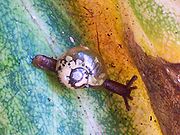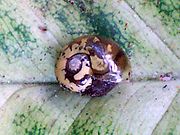
Mysticarion porrectus
Encyclopedia
Mysticarion porrectus, also known as Helicarion porrectus, is a tree-dwelling snail in the family Helicarionidae
. It is endemic to Australia. This species occurs in and near rainforest
s at high altitude in eastern Australia. It is associated with Gondwana
cool temperate rainforests, with trees such as Antarctic Beech
, Sassafras
and Pinkwood.
Mysticarion porrectus is found between Mount Dromedary in south east New South Wales
up the Great Dividing Range
to Mount Superbus
, 150 km south west of Brisbane, Queensland
The shell of this Mysticarion species is too small for the soft parts to completely retract into. This gastropod is what is referred to as a "semi slug": through the course of evolution, the shell has become reduced in size and thickness so that now it mainly offers some protection to the visceral organs. This phenomenon of shell reduction has occurred independently across a number of different families. In some families such as the Athoracophoridae
, Cystopeltidae
and Limacidae
the shell has either completely disappeared or has been so reduced in size as to become a small internal plate – these animals are known as slugs, which are simply snails that have lost their external shell through the course of evolution. It is thought that shell reduction in some families has occurred because of a shortage in calcium carbonate in the local rocks or soil; this calcium carbonate is needed by snails to manufacture their shells.
In the Helicarionidae, shell types range across almost the whole spectrum, from species with large, fully formed shells they can withdraw back into, to those with very reduced ear-shaped or plate-like shells that are partly or almost completely internal, and which sit on their backs like a saddle.
The snail often rests on leaves of shrubs and saplings, and also on the trunks of larger trees. It usually rests on its side, with the end part of its tail curved back. This tail area can act as a suction cup and because of the snail's habit of resting on leaves, these animals can be accidentally and unknowingly picked up by other animals, or even by cars and human beings, that brush against the foliage. Most arboreal snails have very sticky mucus, and this "hitchhiking" capability may account for the very extensive distributions of some of the smaller species, as they could easily travel on the feet or legs of birds or bats.
n family because they are restricted mainly to parts of the southern hemisphere
and Southeast Asia
, including Oceania
and South Africa
.
In Australia, most helicarionids are found along the eastern coast and ranges, particularly in the Border Ranges
and Wet Tropics bioregions. A few species occur in South Australia, one species occurs in the high rainfall area in the south west of Western Australia
and two species are found in the Kimberley region.



Helicarionidae
Helicarionidae is a family of air-breathing land snails or semi-slugs, terrestrial pulmonate gastropod mollusks in the superfamily Helicarionoidea.- Distribution :...
. It is endemic to Australia. This species occurs in and near rainforest
Rainforest
Rainforests are forests characterized by high rainfall, with definitions based on a minimum normal annual rainfall of 1750-2000 mm...
s at high altitude in eastern Australia. It is associated with Gondwana
Gondwana
In paleogeography, Gondwana , originally Gondwanaland, was the southernmost of two supercontinents that later became parts of the Pangaea supercontinent. It existed from approximately 510 to 180 million years ago . Gondwana is believed to have sutured between ca. 570 and 510 Mya,...
cool temperate rainforests, with trees such as Antarctic Beech
Nothofagus moorei
Nothofagus moorei, is an important Gondwana relict of the rainforests of the southern hemisphere. It occurs in wet, fire free areas at high altitude in eastern Australia....
, Sassafras
Doryphora sassafras
Doryphora sassafras, commonly known as Sassafras, Yellow-, Canary- or Golden sassafras, or Golden Deal, is a species of evergreen tree of the family Atherospermataceae native to the subtropical and temperate rainforests of eastern New South Wales and Queensland, Australia...
and Pinkwood.
Mysticarion porrectus is found between Mount Dromedary in south east New South Wales
New South Wales
New South Wales is a state of :Australia, located in the east of the country. It is bordered by Queensland, Victoria and South Australia to the north, south and west respectively. To the east, the state is bordered by the Tasman Sea, which forms part of the Pacific Ocean. New South Wales...
up the Great Dividing Range
Great Dividing Range
The Great Dividing Range, or the Eastern Highlands, is Australia's most substantial mountain range and the third longest in the world. The range stretches more than 3,500 km from Dauan Island off the northeastern tip of Queensland, running the entire length of the eastern coastline through...
to Mount Superbus
Mount Superbus
Mount Superbus lies 150 km south-west of Brisbane and is South East Queensland's highest peak at 1375 metres . At this elevation it is the third highest peak in Queensland. Only Mount Bellenden Ker at 1593 m and Mount Bartle Frere at 1622 m in Far North Queensland are higher.It has an...
, 150 km south west of Brisbane, Queensland
Description
The shell of this snail species is very thin and transparent, so the brightly coloured internal organs are visible through it. The animal has a gland at the end of its tail which is thought to emit pheromones during courtship.The shell of this Mysticarion species is too small for the soft parts to completely retract into. This gastropod is what is referred to as a "semi slug": through the course of evolution, the shell has become reduced in size and thickness so that now it mainly offers some protection to the visceral organs. This phenomenon of shell reduction has occurred independently across a number of different families. In some families such as the Athoracophoridae
Athoracophoridae
Athoracophoridae, common name the leaf-veined slugs, are a family of air-breathing land slugs, terrestrial pulmonate gastropod mollusks in the infraorder Stylommatophora, the stalk-eyed snails and slugs...
, Cystopeltidae
Cystopeltidae
Cystopeltidae is a family of air-breathing land slugs, terrestrial pulmonate gastropod mollusks in the superfamily Punctoidea .-Genera and species :...
and Limacidae
Limacidae
Limacidae, common name the keelback slugs, are a taxonomic family of medium-sized to very large, air-breathing land slugs, terrestrial pulmonate gastropod molluscs in the superfamily Limacoidea.- Distribution :...
the shell has either completely disappeared or has been so reduced in size as to become a small internal plate – these animals are known as slugs, which are simply snails that have lost their external shell through the course of evolution. It is thought that shell reduction in some families has occurred because of a shortage in calcium carbonate in the local rocks or soil; this calcium carbonate is needed by snails to manufacture their shells.
In the Helicarionidae, shell types range across almost the whole spectrum, from species with large, fully formed shells they can withdraw back into, to those with very reduced ear-shaped or plate-like shells that are partly or almost completely internal, and which sit on their backs like a saddle.
Ecology
This species is thought to be a herbivore which scrapes biofilm such as algae and sooty mould off the surface of living leaves.The snail often rests on leaves of shrubs and saplings, and also on the trunks of larger trees. It usually rests on its side, with the end part of its tail curved back. This tail area can act as a suction cup and because of the snail's habit of resting on leaves, these animals can be accidentally and unknowingly picked up by other animals, or even by cars and human beings, that brush against the foliage. Most arboreal snails have very sticky mucus, and this "hitchhiking" capability may account for the very extensive distributions of some of the smaller species, as they could easily travel on the feet or legs of birds or bats.
Distribution
The Helicarionidae are thought to be a GondwanaGondwana
In paleogeography, Gondwana , originally Gondwanaland, was the southernmost of two supercontinents that later became parts of the Pangaea supercontinent. It existed from approximately 510 to 180 million years ago . Gondwana is believed to have sutured between ca. 570 and 510 Mya,...
n family because they are restricted mainly to parts of the southern hemisphere
Southern Hemisphere
The Southern Hemisphere is the part of Earth that lies south of the equator. The word hemisphere literally means 'half ball' or "half sphere"...
and Southeast Asia
Southeast Asia
Southeast Asia, South-East Asia, South East Asia or Southeastern Asia is a subregion of Asia, consisting of the countries that are geographically south of China, east of India, west of New Guinea and north of Australia. The region lies on the intersection of geological plates, with heavy seismic...
, including Oceania
Oceania
Oceania is a region centered on the islands of the tropical Pacific Ocean. Conceptions of what constitutes Oceania range from the coral atolls and volcanic islands of the South Pacific to the entire insular region between Asia and the Americas, including Australasia and the Malay Archipelago...
and South Africa
South Africa
The Republic of South Africa is a country in southern Africa. Located at the southern tip of Africa, it is divided into nine provinces, with of coastline on the Atlantic and Indian oceans...
.
In Australia, most helicarionids are found along the eastern coast and ranges, particularly in the Border Ranges
Border Ranges
Border Ranges can refer to:* Border Ranges National Park, a National Park north of Sydney, Australia* Border Ranges , a mountain range of the Rocky Mountains, on the border between Canada and the United States...
and Wet Tropics bioregions. A few species occur in South Australia, one species occurs in the high rainfall area in the south west of Western Australia
Western Australia
Western Australia is a state of Australia, occupying the entire western third of the Australian continent. It is bounded by the Indian Ocean to the north and west, the Great Australian Bight and Indian Ocean to the south, the Northern Territory to the north-east and South Australia to the south-east...
and two species are found in the Kimberley region.




